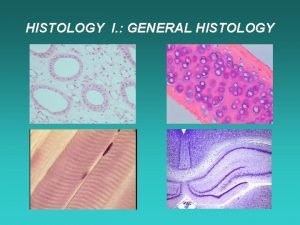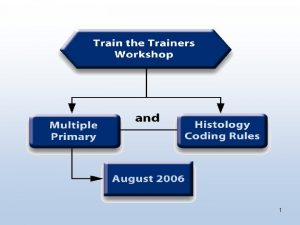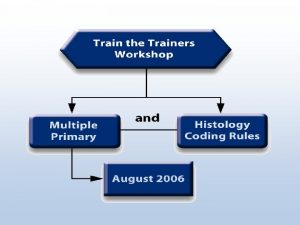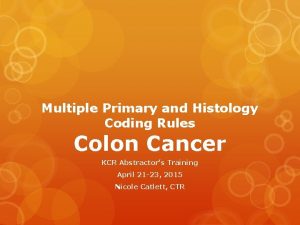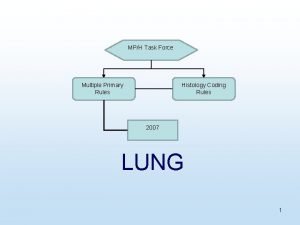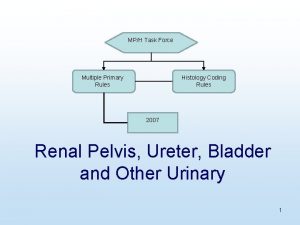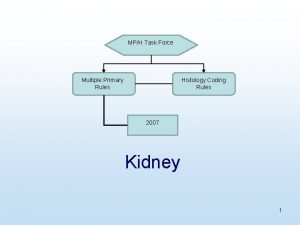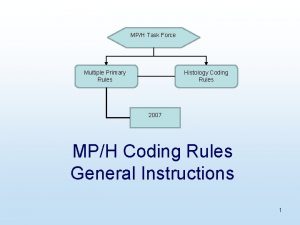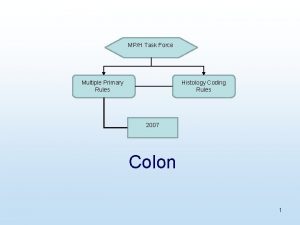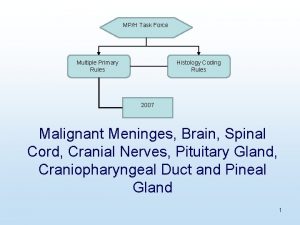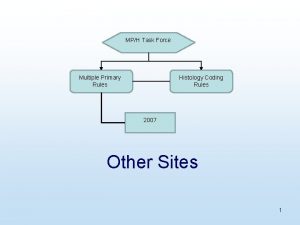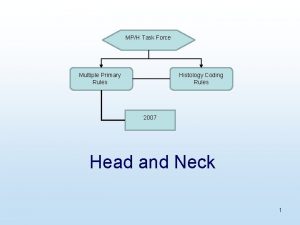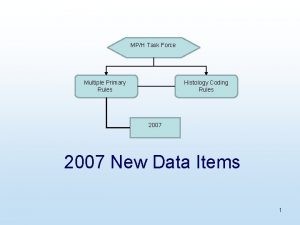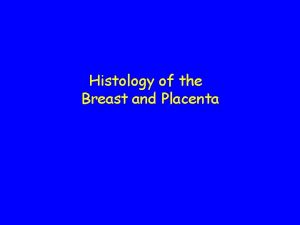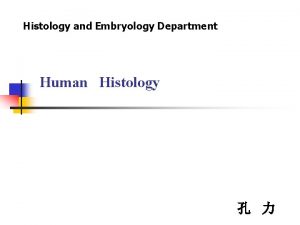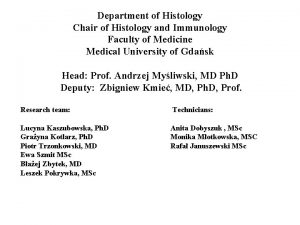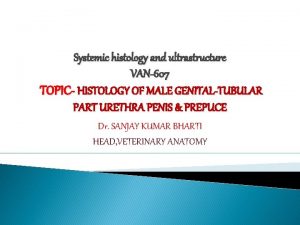1 Multiple Primary and Histology Rules Changes The




























- Slides: 28

1

Multiple Primary and Histology Rules Changes The Problem

Multiple Primary and Histology Coding Rules--Lung Case 1: Poorly differentiated non-small cell lung carcinoma (mixed large cell undifferentiated and adenocarcinoma) Case 2: Lung with moderately differentiated adenocarcinoma, mucin secreting cells, mixed acinar, papillary, and bronchioalveolar features Case 3: Poorly differentiated carcinoma, non-small cell type 3

Multiple Primary and Histology Coding Rules--Lung Current Rules Issues: §Too many descriptors §Too many choices for histology codes §No hierarchy of rules when there are choices 4

Multiple Primary and Histology Coding Rules--Lung Case 4: Lung, right upper lobectomy: 2 nodules of carcinoma with mucin production (c/w pulmonary primary), one nodule has bronchoalveolar features, the other shows focal squamous differentiation 5

Multiple Primary and Histology Coding Rules--Lung Current Rules Issues: §One primary or more? §Too many descriptors and ambiguous terms §Multiple choices for histology codes adenocarcinoma, squamous cell carcinoma, bronchioloalveolar adenocarcinoma, bronchiolo-alveolar carcinoma (mucinous) §No hierarchy of rules when there are choices 6

Overview • • • Problem identification Problem definition Purpose of new rules Committee structure Rules development process Project timeline Field study Final product National training 7

Problem Identification Quality Improvement Studies SINQ and I&R Registrar and Researcher Inquiries 8

Problem Identification: Current Rules • 25 year old rules • Site-specific exceptions • Difficult to train • Could not flowchart 9

Problem Definition • ICD-O-3 – New terms and new codes • Non standard usage of nomenclature 10

Problem Definition • Changes in clinical practice • Technology advances – More histology characteristics descriptors – Electron microscopy to immunohistochemistry 11

Conclusion • Existing rules were not effective • Adding additional modifications to the modifications made over time would only add more confusion • Too many site specific exceptions • Training very challenging 12

Why New Rules Are Needed The Plan 13

Committee Structure CDC NPCR Pathologist 15 CR Reps Co. C AJCC SEER NAACCR Stat Canada NCRA 14

Purpose of New Rules • Promote consistency in coding – Clarify multiple primary rules – Clarify histology coding rules • Preserve integrity of incidence rates and trends • Improve quality of data 15

Why Site-Specific Rules? • General rules cannot address site-specific issues – Histologies – Disease process for that site – Valid mixed and combination histology codes 16

Primary Sites • Lung • Colon • Breast • Kidney • Renal pelvis, ureter, and bladder • Head and neck • Melanoma • Brain 17

Rules Development Process § Subcommittee develops rules § Ad hoc consultation specialty physicians § Committee: Review and revise § Ad hoc consultation ICD-O-3 editors 18

Rules Development Process § Editing committee: Review, revise, format § Web-based Feasibility Testing § Hospital-based registrars § Central registry coders and abstractors § Independent contractors 19

Rules Development Process • Analysis of Beta results – Revision • Presentation to Co. C clinical advisors – Revision • Committee review • Presentation to NAACCR ROC 20

Project Timeline • Committee formed January 2003 – Videoconferences 2003 -- 2006 • Beta testing of rules started September 2004 • Concept presented to NAACCR Registry Operations Committee January 2005 • Presentations to COC Clinical Advisory Panels started February 2005 21

Project Timeline • Statistical impact meetings started April 2005 • SEER Workshop at NCRA April 2005 • Decision to delay implementation to 2007 made June 2005 • Train the Trainers Workshop September 2005 • Planning for 2006 field studies began during last quarter of 2005 22

Field Studies • Develop protocol October 2005 • Select participants November 2005 – Hospital – Central Registry • Training participants January 2006 • Field study conducted February 2006 23

MP/H Reliability Study Participants abstracted and coded 20 medical records 10 each from 2 of the 9 site groups 1. Lung 2. Colon 3. Breast 4. Melanoma 5. Head and Neck 6. Kidney 7. Renal Pelvis, Ureter, and Bladder 8. Brain 9. All Other Sites 24

MP/H Reliability Study STUDY PARTICIPANTS • ACo. S Co. C (representing tumor registrars from Co. C approved hospitals) • Canadian cancer registries • CDC NPCR • NCI SEER Program • NCRA (representing tumor registrars from non-Co. C approved hospitals) • Other non-affiliated participants, such as independent contractors and vendors 25

Project Timeline • Tabulation/evaluation of field study and reliability study results April 2006 • Revision of MP/H materials May 2006 • Publication of final materials July 2006 26

Project Timeline • Additional training materials published on web • Train the Trainers Workshop II August 2006 • Implementation planned for cases diagnosed January 1, 2007 and after • Trainings at National Meetings • You as the trained trainer 27

MP/H Task Force 28
 Elizabeth mulroney
Elizabeth mulroney Chemical change examples pictures
Chemical change examples pictures Baseline
Baseline Shared memory mimd architecture
Shared memory mimd architecture Multiple choice questions for primary students
Multiple choice questions for primary students Hình ảnh bộ gõ cơ thể búng tay
Hình ảnh bộ gõ cơ thể búng tay Slidetodoc
Slidetodoc Bổ thể
Bổ thể Tỉ lệ cơ thể trẻ em
Tỉ lệ cơ thể trẻ em Chó sói
Chó sói Chụp phim tư thế worms-breton
Chụp phim tư thế worms-breton Alleluia hat len nguoi oi
Alleluia hat len nguoi oi Kể tên các môn thể thao
Kể tên các môn thể thao Thế nào là hệ số cao nhất
Thế nào là hệ số cao nhất Các châu lục và đại dương trên thế giới
Các châu lục và đại dương trên thế giới Công thức tiính động năng
Công thức tiính động năng Trời xanh đây là của chúng ta thể thơ
Trời xanh đây là của chúng ta thể thơ Mật thư tọa độ 5x5
Mật thư tọa độ 5x5 Làm thế nào để 102-1=99
Làm thế nào để 102-1=99 Phản ứng thế ankan
Phản ứng thế ankan Các châu lục và đại dương trên thế giới
Các châu lục và đại dương trên thế giới Thể thơ truyền thống
Thể thơ truyền thống Quá trình desamine hóa có thể tạo ra
Quá trình desamine hóa có thể tạo ra Một số thể thơ truyền thống
Một số thể thơ truyền thống Cái miệng xinh xinh thế chỉ nói điều hay thôi
Cái miệng xinh xinh thế chỉ nói điều hay thôi Vẽ hình chiếu vuông góc của vật thể sau
Vẽ hình chiếu vuông góc của vật thể sau Biện pháp chống mỏi cơ
Biện pháp chống mỏi cơ đặc điểm cơ thể của người tối cổ
đặc điểm cơ thể của người tối cổ Thế nào là giọng cùng tên
Thế nào là giọng cùng tên






























